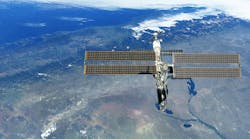Snapdragon Satellite Communication Open to Everyone
This article appeared in Electronic Design and has been published here with permission.
Check out more of our CES 2023 coverage
What you’ll learn
- What is the Snapdragon Satellite chip, and what can it do?
- Who can benefit using the Snapdragon 8 Gen 2 chipset.
- When it will be available.
Companies from all over the world unveiled their latest innovative tech at the recently concluded Consumer Electronics Show (CES). Among that tech includes Qualcomm’s just-announced Snapdragon Satellite, an integrated circuit designed to enable satellite connectivity in mobile devices.
The satellite connectivity is made available not only by the chipset, but through a partnership with Iridium, a satellite company that’s been putting satellites into orbit since the 1990s. Iridium currently operates a network of low-Earth-orbit (LEO) satellites that orbit approximately 485 miles above the Earth.
Wireless communications operate at L-band frequencies, which are located in the 1- to 2-GHz frequency range. This yields multiple benefits. First, it allows for a small antenna size—a critical feature for mobile devices. Second, it’s more resilient to attenuation due to weather conditions, unlike other satellite communications. Overall, the constellation creates a global mesh that allows for coverage from anywhere on earth with clear visibility of the sky.
The service is similar to what Apple offers with its latest iPhone. In addition, T-Mobile is exploring a partnership with Space-X to enable emergency communications in remote locations (see figure). The difference Qualcomm and Iridium are offering, though, is that any device using the chipset would be capable of satellite communications. Moreover, it’s not limited to any single brand or phone service. In fact, the chipset is expandable to any mobile device that would utilize the Snapdragon chipset; this can be laptops or even automobiles.
The way the service will work is by a user first inputting the message they desire to send. Next, the phone will prompt the user to point the phone to the sky and turn to locate a satellite. The message can then be sent, which will nominally take a few seconds after a satellite is found. The data transfer is limited to 140 bytes, which will only permit short text messages to be sent. However, two-way messaging isn’t limited to emergency-only use. Thus, it can provide a means of temporary or brief communication to users in remote locations.
Any device looking to utilize the Snapdragon Satellite service also must be equipped with Qualcomm’s latest Snapdragon 8 Gen 2 chipset. This processor provides the modem needed for signal processing for satellite communications. While some of the upcoming high-end Android phones will come equipped with the latest Snapdragon processor, they will not yet be capable of satellite communications. The earliest we can expect to see phones with Qualcomm’s Snapdragon Satellite support will be in the latter half of 2023.

